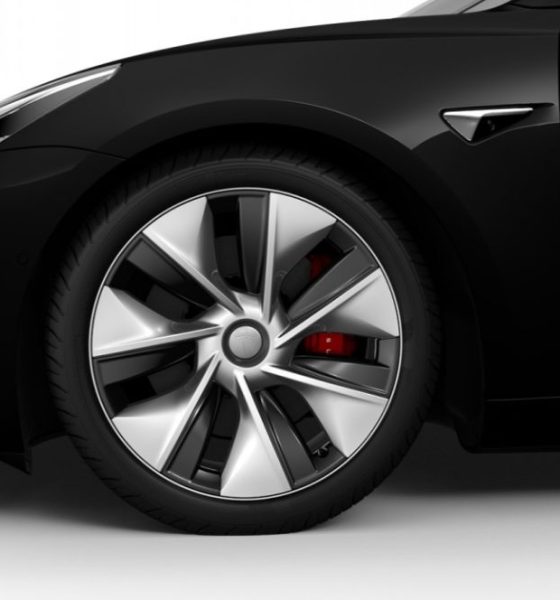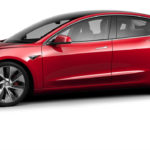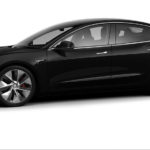

News
Tesla Model 3 Performance gets 19-inch “Power Sports” Aero Wheels in China
Just a few days into 2019, Tesla has opened the Model 3 configurator to customers in China and select European territories, allowing reservation holders to design and order the electric sedan. With this, Tesla has begun laying the foundations of the Model 3’s international ramp, which is expected to hit its stride in the coming months.
Within the configuration pages of the Model 3 in China, though, lay a rather surprising detail. When designing the Model 3 Performance in Tesla’s Chinese website, a new type of wheel for the vehicle was listed as an option. Instead of the 20″ Sport Wheels that are offered with the Model 3 Performance in the United States, China-bound vehicles are offered with 19″ “Power Sports” wheels.
The Model 3 Performance’s 19″ Power Sports wheels. (Credit: Tesla)
Tesla notes in the items’ description that the Power Sports wheels are designed for “balanced performance and cruising range.” Just like the 18″ Aero Wheel covers in North American vehicles, the 19″ Power Sports wheels include a detachable hubcap that can “better adapt to different road conditions.” Based on Tesla’s Model 3 configurator in China, the 19″ Power Sports wheels are exclusive to the Model 3 Performance; thus, customers who order the Long Range AWD Model 3 are only able to choose between the familiar 18″ Aero Wheels and the 19″ Sports Wheels found in North American units.
Tesla appears to have done a great job in designing the 19″ Power Sports wheels. Unlike the 18″ Aero Wheels, whose design is still polarizing, the 19″ Power Sports wheels could only be described as a very good balance between form and function. While it is unfortunate that the Power Sport wheels are currently unavailable for Model 3 in regions outside China, one can only hope that the wheels might eventually be released to other regions in the near future.
Considering that the new wheels have aero components, it would be quite interesting to see how Tesla’s new Power Sports wheels affect the Model 3 Performance’s range. That said, if their range optimization capabilities are anywhere close to the company’s 18″ Aero Wheels, then the 19″ Power Sports wheels could very well be the best wheel option for the Model 3 that the electric car maker has introduced to date.
The Tesla Model 3 Performance is poised to become a strong contender in China’s high-performance sedan market. Being capable of accelerating from 0-60 mph in 3.5 seconds, the vehicle is incredibly quick, and thanks to the Track Mode update, the car is capable of being driven on a closed circuit. Perhaps even more notable, though, is the vehicle’s price.
Last month, the Chinese State Council Customs Tariff Commission announced that it was suspending the extra 25% tariffs it placed on cars and parts being imported from the United States. This resulted in Tesla adjusting the Model 3 Performance’s price from a rather steep 689,000 RMB (roughly $100,000) to a more reasonable 560,000 RMB (around $81,000). At these prices, the Model 3 Performance actually undercuts some of its most notable fossil fuel powered rivals such as the BMW M3 and the Mercedes-AMG C 63 Coupe, which cost as much as 998,000 RMB ($162,000) and 1,198,000 RMB ($173,623), respectively.
With its current price, Tesla has practically made the Model 3 Performance one of the most bang-for-your-buck high-performance sedans in China.

Elon Musk
Starlink passes 9 million active customers just weeks after hitting 8 million
The milestone highlights the accelerating growth of Starlink, which has now been adding over 20,000 new users per day.

SpaceX’s Starlink satellite internet service has continued its rapid global expansion, surpassing 9 million active customers just weeks after crossing the 8 million mark.
The milestone highlights the accelerating growth of Starlink, which has now been adding over 20,000 new users per day.
9 million customers
In a post on X, SpaceX stated that Starlink now serves over 9 million active users across 155 countries, territories, and markets. The company reached 8 million customers in early November, meaning it added roughly 1 million subscribers in under seven weeks, or about 21,275 new users on average per day.
“Starlink is connecting more than 9M active customers with high-speed internet across 155 countries, territories, and many other markets,” Starlink wrote in a post on its official X account. SpaceX President Gwynne Shotwell also celebrated the milestone on X. “A huge thank you to all of our customers and congrats to the Starlink team for such an incredible product,” she wrote.
That growth rate reflects both rising demand for broadband in underserved regions and Starlink’s expanding satellite constellation, which now includes more than 9,000 low-Earth-orbit satellites designed to deliver high-speed, low-latency internet worldwide.
Starlink’s momentum
Starlink’s momentum has been building up. SpaceX reported 4.6 million Starlink customers in December 2024, followed by 7 million by August 2025, and 8 million customers in November. Independent data also suggests Starlink usage is rising sharply, with Cloudflare reporting that global web traffic from Starlink users more than doubled in 2025, as noted in an Insider report.
Starlink’s momentum is increasingly tied to SpaceX’s broader financial outlook. Elon Musk has said the satellite network is “by far” the company’s largest revenue driver, and reports suggest SpaceX may be positioning itself for an initial public offering as soon as next year, with valuations estimated as high as $1.5 trillion. Musk has also suggested in the past that Starlink could have its own IPO in the future.
News
NVIDIA Director of Robotics: Tesla FSD v14 is the first AI to pass the “Physical Turing Test”
After testing FSD v14, Fan stated that his experience with FSD felt magical at first, but it soon started to feel like a routine.

NVIDIA Director of Robotics Jim Fan has praised Tesla’s Full Self-Driving (Supervised) v14 as the first AI to pass what he described as a “Physical Turing Test.”
After testing FSD v14, Fan stated that his experience with FSD felt magical at first, but it soon started to feel like a routine. And just like smartphones today, removing it now would “actively hurt.”
Jim Fan’s hands-on FSD v14 impressions
Fan, a leading researcher in embodied AI who is currently solving Physical AI at NVIDIA and spearheading the company’s Project GR00T initiative, noted that he actually was late to the Tesla game. He was, however, one of the first to try out FSD v14.
“I was very late to own a Tesla but among the earliest to try out FSD v14. It’s perhaps the first time I experience an AI that passes the Physical Turing Test: after a long day at work, you press a button, lay back, and couldn’t tell if a neural net or a human drove you home,” Fan wrote in a post on X.
Fan added: “Despite knowing exactly how robot learning works, I still find it magical watching the steering wheel turn by itself. First it feels surreal, next it becomes routine. Then, like the smartphone, taking it away actively hurts. This is how humanity gets rewired and glued to god-like technologies.”
The Physical Turing Test
The original Turing Test was conceived by Alan Turing in 1950, and it was aimed at determining if a machine could exhibit behavior that is equivalent to or indistinguishable from a human. By focusing on text-based conversations, the original Turing Test set a high bar for natural language processing and machine learning.
This test has been passed by today’s large language models. However, the capability to converse in a humanlike manner is a completely different challenge from performing real-world problem-solving or physical interactions. Thus, Fan introduced the Physical Turing Test, which challenges AI systems to demonstrate intelligence through physical actions.
Based on Fan’s comments, Tesla has demonstrated these intelligent physical actions with FSD v14. Elon Musk agreed with the NVIDIA executive, stating in a post on X that with FSD v14, “you can sense the sentience maturing.” Musk also praised Tesla AI, calling it the best “real-world AI” today.
News
Tesla AI team burns the Christmas midnight oil by releasing FSD v14.2.2.1
The update was released just a day after FSD v14.2.2 started rolling out to customers.

Tesla is burning the midnight oil this Christmas, with the Tesla AI team quietly rolling out Full Self-Driving (Supervised) v14.2.2.1 just a day after FSD v14.2.2 started rolling out to customers.
Tesla owner shares insights on FSD v14.2.2.1
Longtime Tesla owner and FSD tester @BLKMDL3 shared some insights following several drives with FSD v14.2.2.1 in rainy Los Angeles conditions with standing water and faded lane lines. He reported zero steering hesitation or stutter, confident lane changes, and maneuvers executed with precision that evoked the performance of Tesla’s driverless Robotaxis in Austin.
Parking performance impressed, with most spots nailed perfectly, including tight, sharp turns, in single attempts without shaky steering. One minor offset happened only due to another vehicle that was parked over the line, which FSD accommodated by a few extra inches. In rain that typically erases road markings, FSD visualized lanes and turn lines better than humans, positioning itself flawlessly when entering new streets as well.
“Took it up a dark, wet, and twisty canyon road up and down the hill tonight and it went very well as to be expected. Stayed centered in the lane, kept speed well and gives a confidence inspiring steering feel where it handles these curvy roads better than the majority of human drivers,” the Tesla owner wrote in a post on X.
Tesla’s FSD v14.2.2 update
Just a day before FSD v14.2.2.1’s release, Tesla rolled out FSD v14.2.2, which was focused on smoother real-world performance, better obstacle awareness, and precise end-of-trip routing. According to the update’s release notes, FSD v14.2.2 upgrades the vision encoder neural network with higher resolution features, enhancing detection of emergency vehicles, road obstacles, and human gestures.
New Arrival Options also allowed users to select preferred drop-off styles, such as Parking Lot, Street, Driveway, Parking Garage, or Curbside, with the navigation pin automatically adjusting to the ideal spot. Other refinements include pulling over for emergency vehicles, real-time vision-based detours for blocked roads, improved gate and debris handling, and Speed Profiles for customized driving styles.











